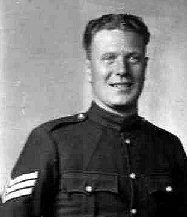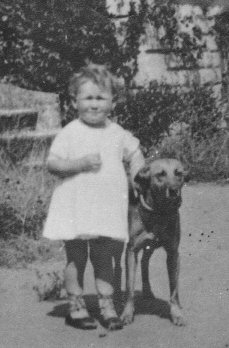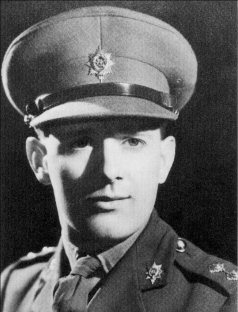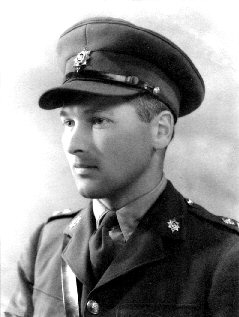1st Battalion Worcestershire Regiment - Mouen 1944
The Battalion curled up in its shallow slit trenches about 03.00 hrs (28th June 1944). At 03.30 the C.O. was sent for to Brigade H.Q. (who were about a mile north of Cheux) and informed that, notwithstanding the vagueness of information, the Brigade had been ordered to capture Mouen that morning by 08.00 hrs. Accordingly the Brigade Commander ordered the 1st Worcestershire Regiment to attack and capture the village of Mouen up to the road at map reference 936654 (see map below) and exploit down to the main Villers Bocage-Caen Road. On success, 7th Somerset Light Infantry were to pass through and probably would be given as an objective the ground between the main road and the River Odon and possibly the wooded country beyond. The attack was to be without armoured support, but two Medium Regiments, the Divisional Artillery, one Company of M.M.G. (1 Mx) and one Platoon 4.2-in. Mortars were to be in support. As time was so short it was impossible to make a reconnaissance of the ground and then get back to make the artillery plan with any hope of its being ready by zero hour. From the map and the reconnaissances made the previous evening it was clear that the country was flat open cornfield for about half a mile, finishing at the Villers Bocage-Caen railway. Immediately the other side of this railway the country became very close with small orchards and high hedges.

Lieut.-Col Harrison (left) having an ‘O’ Group with his officers preparing for the attack on Mouen (28th June 1944)
Mouen was a small hamlet lying in this close country and intersected with two or three Devonshire type lanes. Beyond, still in close country, was the main Villers-Caen road and the River Odon with high ground (Hill 112) behind. On its right the country was open for about half a mile and then became close and full of orchards. On the left the ground sloped away with large cornfields until it met Carpicquet Aerodrome. Accordingly it was decided to attack almost directly on the axis Cheux-Mouen; the reason being that two previous unsuccessful attacks had been made round to the right, the obvious line of approach (being close country), and by taking the direct route which was over open country and did not appear good infantry ground, surprise (under cover of smoke) would probably be obtained; also de-filade from Carpicquet Aerodrome—anyway, that appeared to be so from the map. A warning order was sent forward to the Battalion and arrangements there made to get the hot breakfast up in containers and eaten before zero. The artillery plan (arranged with Major Backhouse, now comd. 179 Field Regiment) was for a barrage of H.E. with smoke mixed, opening on the line of the railway short of the village of Mouen, dwelling there for thirty minutes (which was the estimated time for the advance across the open country), then moving forward at 100 yards in four minutes to the main Caen road and there dwelling. The mortars of the Battalion were to take on opportunity targets and those of 7th Somerset Light Infantry (also under command) to fire phosphorus smoke into the barrage both for blinding and lethal effect. 4.2-in. mortars were to fire smoke and H.E. on Bas-du-Mouen which appeared the obvious line of counter-attack from Carpicquet and Caen, and the medium machine guns were to fire on Carpicquet Aerodrome not only to neutralize but also as deception.
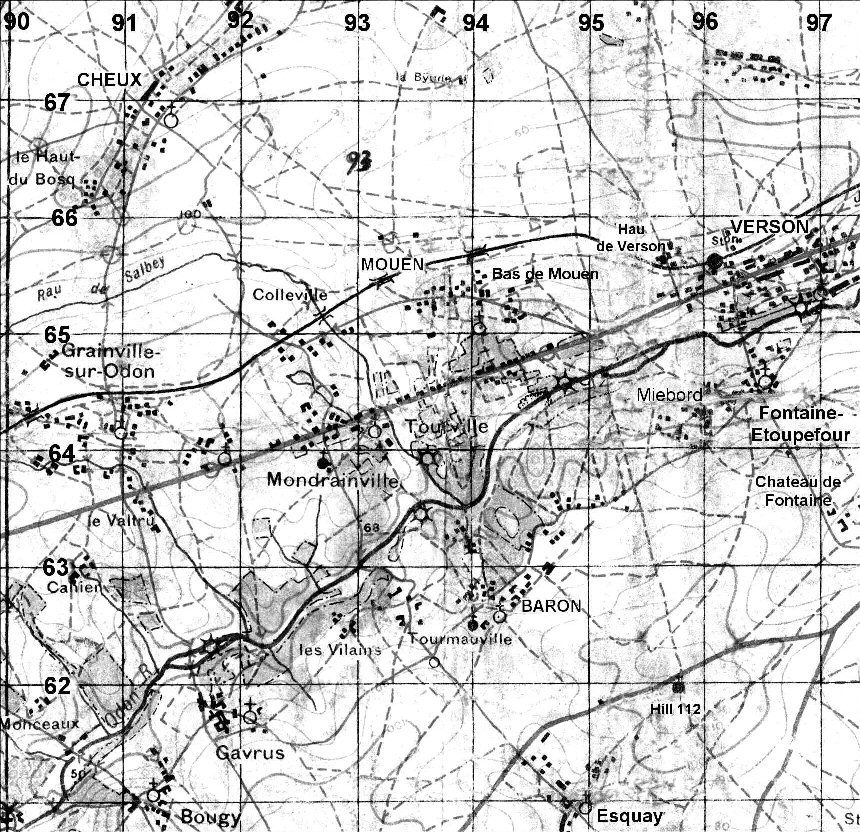
Mouen area map with map reference grid (grid scale is 1km)
Battle drill procedure went well and in due course C.O.’s orders were given out at map reference 920668 (see map above). All that could be seen of Mouen was merely a long line of trees stretching from right to left on the skyline, but a bearing off the map of the axis of attack showed that it coincided exactly with a line of electric light poles going through the corn. Accordingly orders were given for 'B' Company right—objective the village of Mouen from the right to the Church, 'C' Company left—objective village of Mouen to left of Church (keeping its left on the line of electric poles); in support 'A' Company moving to the left on reaching the railway—objective Bas-du-Mouen and covering the left flank; 'D' Company in reserve. Battle drill procedure right down to Section Commanders worked as if on a demonstration, and all groups could be seen going forward and coming back. In fact it worked so well that there was time for a C.O.’s co-ordinating conference. The attack started dead on time and the Battalion moved forward through the cornfield in copy-book style. Not a man seemed out of place and never had the Battalion gone into attack so well in any training. The depth was about half a mile.
Forward Companies suffered casualties during the approach from enemy air-burst shrapnel and these casualties included some of the precious assault pioneers, two of whom had been attached to each forward Company. Some opposition from automatic fire was met with on coming to the railway line, but our artillery had opened very accurately on that line and neutralized most opposition there.
However, directly the Companies got over the line they found themselves in real close country consisting of small fields with high hedges and sunken lanes. In these hedges, lanes, and in the tops of trees, there was still a large number of Germans very much alive. Progress forward was slow as each little orchard had to be dealt with separately before going on to the next if control was to be retained. In addition, there were some enemy tanks which had dug themselves in the narrow lanes and were being used as pill-boxes. One of these was very successfully dealt with by a PIAT, an early success with this weapon which was very heartening and it soon became popular, not only for jobs such as this, but also for routing out the enemy in hedges and lanes. In due course, but taking rather longer than anticipated owing to the close country, the Battalion got its objectives and the anti-tank guns and carriers came up under O.C. 'Sp' Company. Casualties were not heavy, mainly owing to the very open formation adopted in the approach (about eight yards between men) and also because of the systematic clearing of each pocket of resistance as it was met. Major Gutch was hit in the neck but refused to go back until his Company was dug in. He was later awarded the M.C. for his leadership in this attack. 'C' Company also lost Lieut. Richards, who received what was to be the first of his wounds, as well as Lieut. Hall. 'B' Company lost Lieut. Brigider, a most lion-hearted and magnificent Canadian officer, who had his heel blown off early in the attack. Luckily he was not killed, but he was very greatly missed. Sergt. Stupple, an old warrior who had a few scores to pay back for Tobruk, took advantage of the occasion and did great work for which, later, he was awarded the M.M.
R.S.M. Hurd
Sgt. E. S. Hickman |
Lieut. Jack Booth of ‘B’ Company was Mentioned in Despatches for his example and leadership of his Platoon. R.S.M. Hurd distinguished himself by going out on patrol by himself directly the attack was finished and there finding what had been the late enemy H.Q. still occupied by one or two of them. In company with Sgt. Guilfoyle, he got into the building and the Boche cleared off, leaving behind their Nazi Flag which R.S.M. Hurd brought back and presented to Battalion H.Q. Later this hung on the Divisional Commander’s caravan for some weeks, with a note saying that it had been captured by the Battalion. It is now in the Regimental Museum at Norton. This Flag belonged to a Company of the Hitler Jugend Division. Major Weston owed his life to the prompt action of Sergt. Hickman who was with him as mortar fire controller. Major Weston was routing out some local inhabitants who had taken refuge in a deep shelter when suddenly a German appeared from the depths and threw a stick grenade which landed at Major Weston’s feet. Sergt. Hickman immediately picked it up and threw it away, whilst he and Major Weston hurled themselves on the ground. The grenade went off but luckily neither was injured. As fate would have it, Sergt. Hickman was killed only a few days later. Lessons were learned from this most successful attack :— Surprise is almost the most important thing—undoubtedly the attack was not expected either on that axis or without armour. The wholesale use of smoke—particularly for deception on the left—helped this surprise. The value of battle drill procedure, whereby everyone knew exactly where he was going and where everyone else was. Depth helps to minimise casualties from enemy D.F.—men were eight yards apart. Where enemy positions are obscure give Companies their objectives and let them fight Company battles to get there—when once the attack is launched it is difficult to "make any sense" out of a Company Commander who is fully occupied in fighting his Company. This was described by the Divisional Commander as "one of the slickest attacks of the war". |
7th Somerset Light Infantry duly passed through and dug in astride the main Caen road ahead. 5th D.C.L.I. came up on the right and thus, as can be seen from the map, the Brigade was in a salient with 1st Worcestershire Regiment on its left facing the aerodrome of Carpicquet, still very much held by the enemy, with the chimneys of Caen to be seen beyond. It was found that the 11th Armoured Division, which had previously fought their way through Mouen to Esquay, had suffered fairly heavy casualties, a considerable number of their tanks and equipment lying about the place. It was quite clear that the German tanks which had dug themselves in in the narrow lanes had allowed the light tanks of the 11th Armoured and their accompanying Infantry to get up quite close before opening up and it was then almost impossible for our fellows to get at them.
Later in the afternoon it seemed as if the enemy had woken up as to where the thrust was coming and that the village was the main axis, for mortars of every sort and description started to bring their fire down on the position. Casualties started to grow but luckily the Battalion had learnt at Cheux to dig in quickly and had done so.
Companies were disposed as follows :—'D' in orchards forward and to the right; 'B' in similar country to the left of 'D' ; 'C' joined up on the left of 'B' and held the centre of the village round the Church ; 'A' were to the left and in rear of 'C' looking after the approach from Carpicquet and the rear. The carriers filled in the gap between 'A' and 'D' and Battalion H.Q. with the mortars just forward of the railway between 'D' and 'A'. The anti-tank guns were mostly facing the rear, which was the open country.
The first night was most unpleasant as the Boche brought down on Mouen all that seemed to be available and, the position being in a salient, it came from all quarters in particular from Hill 112 which was high ground about two miles ahead completely dominating Mouen and its approaches. Each Company suffered and casualties grew. The M.O. (Capt. Duff-Chalmers) with Sergt. Hodgetts and the stretcher-bearers, worked magnificently and no call went unanswered. In particular, when a 3-in. mortar pit received a direct hit during the night, stretcher bearers went about their task in the blackness although bombs were falling all round. The R.A.P., consisting of a series of slits, received its share of mortaring and the Medical Sergt. (Sergt. Hodgetts) was badly wounded. Many bursts of spandau fire were heard in the area of the adjoining Battalion but this later turned out to be from our own troops using captured weapons. A few days later the Brigadier ordered that no enemy weapons were to be used at night. A brief survey on the following day showed that the position had been held by a Boche Company supported by numerous additional heavy mortars and containing many O.P.s for supporting arms. Few prisoners were taken—the village was a scene of dead Germans and equipment including an ambulance which apparently had been hit by our artillery. It was rumoured that our M.O. was delighted to find that his opposite number thought fit to carry a bottle of champagne amongst the medical comforts. A bottle or two of the fire water known as Calvados was here unearthed for the first time and dealt with accordingly—it was the first drink of alcohol that had come our way since leaving England. |
Sergt. Hodgetts |
Francoise Clement (killed 27 June 1944, Mouen) (provided by Rosanna Coates daughter |
'C' Company had the rather sad experience of finding a young French child (girl) dead in one of the farmhouses. She had apparently been killed by shellfire but some of the Company dug a grave in the adjoining churchyard and she was buried and a cross put up. Apparently somehow this got known, as not only was it reported in some English Sunday paper but the mother of the child, who had been evacuated towards the beaches, later got to hear of it and sent a message to the Battalion saying how deeply grateful she was for all they had done. Private Joseph Beasley of the 1st Battalion who was one of the men who found the child also found a photo (opposite) and kept it in memory of this tragedy. The Battalion was worried with continued sniping and it was found that quite a number of Boche were still hiding in the hedges and trees. Accordingly, as a routine every evening and morning, all the hedges were sprayed by small parties going out with sten guns and it was surprising the number of Boche that were got in this way. Incidentally a number of O.P.s were found constructed by the Boche in tall trees—these consisted of platforms carefully concealed. At the end of two days the opposing mortar fire showed no slackening and our artillery was still firing almost continuously, as it had been ever since our attack went in. Determined counter attacks were made by the Boche against the salient and some elements got as far as Cheux now well to our rear. Most of these attacks came from over to our right and were all finally beaten off—the R.A.F. greatly assisting by a mass attack against the opposing armour at Villers Bocage. |

Damaged farm house at Mouen, France, where 'C' Company found the dead child
A day or so later an officer appeared and said that he was in command of a P.E.N. Recorder, an instrument for locating enemy mortars. He was welcomed, given a slit trench and eventually set up his apparatus, producing some results in about twenty-four hours, one of which pointed to what was definitely an enemy mortar position and the other—not so. However it is believed that this was one of the first attempts to use this apparatus, which later proved fairly successful.
The method on which the Battalion had trained and which was used throughout the early part of the campaign was that, directly enemy mortars were heard to fire, one officer per Company took a bearing on the sound of discharge and sent this in immediately to Battalion H.Q. At first the job was looked on with some suspicion but after twenty-four hours or so everyone learned to be adept at judging the time it took for the bombs to arrive. The moaning Minnies were easily recognized and, as they could clearly be heard coming for anything up to 10-15 seconds before they landed, there was ample time to take avoiding action. These respective bearings were consolidated and sent back over the air, usually on the gunner net. All were plotted and certain areas noted as being positions from which the enemy mortars were being fired. Counter mortar tasks on these areas were arranged with the gunners accordingly so that if mortaring was excessively heavy from one particular quarter a counter mortar task was called for over the gunner net and invariably there was a very quick reply by the guns on to all located mortar positions in that area. Later still this was cut down to a mere code word because it was found that the Boche were using mortars mounted on tracked vehicles which moved as soon as they had fired, and it was very necessary to bring down any counter mortar fire almost immediately if it was to have any effect. The results soon showed that this counter mortar policy did lessen the mortar fire of the enemy. The other very effective counter mortar instrument was the Flying O.P. In this sort of country where observation was almost nil so far as we were concerned, it was impossible to locate enemy mortar positions by sight from the ground, and the Flying O.P. was used for this as well as for spotting other targets. It was very noticeable that whenever a Flying O.P. was up there was little or no mortar fire, because these O.P.s simply stooged round in their aircraft watching for the smoke of discharge of an enemy mortar, and immediately brought down artillery fire on to that position. There was little or no doubt that these Flying O.P.s saved the Battalion a lot of casualties, and a great point was that they were on the same net as the Battery Commander, who could call them up straight away on the air and ask them to watch a particular sector. Here let it be recorded that no Battalion could have received better support than we did from 179 Field Regiment and 172 Field Battery in particular. The Battery Commander (Major Alexander) lived in a slit (which many times he dug himself) right alongside the C.O. and Adjutant. He or his assistant were always manning their two wireless sets and no call by the Battalion for assistance ever went unanswered. In fact on many an occasion a Company has been indebted to Major Alexander for calling for counter mortar fire on his own initiative when he felt that things were getting a bit too hot for that particular Company.
Worcesters C.O. and Adjutant slit trenches at Mouen |
The counter attack from Villers Bocage having been beaten off, the position was quieter for a few days, but orders were that during this comparative lull every step short of a full-scale attack should be taken to take offensive action, and accordingly there was continuous patrolling by the Battalion towards Verson and Carpicquet. Also, any target appearing was immediately engaged either by artillery or mortars. The administrative side worked well with the Q.M. or M.T.O. and the C.Q.M.S.s coming up each evening in carriers. They had many an adventurous journey but never failed. Compo rations were still the order of the day, supplemented by any produce, which happened to be growing or lying nearby. The post started to arrive, as also did the English daily papers, which, on one evening a little later, actually arrived on the day of their publication. |
There was a wide "no man’s land" between the Battalion and the enemy positions on Carpicquet and towards Caen because the ground sloped down into a valley between us. Both sides kept out of it except for patrolling. In order to carry out the policy of being as offensive as possible mortar sallies were ordered by the Brigadier, and these became an almost nightly occurrence. The force consisted of all the mortars in the Brigade (both the 4.2-in. and the 3-in.) together with 179 Field Regiment and one Company of Infantry all under the command of one of the C.O.s of the Infantry Battalions. The object was to beat up enemy positions, and usually one such as Jumeaux was chosen for an operation. A reconnaissance was made during the daytime by the C.O., the Company Commander and the three Mortar Commanders to site a position from which the mortars could fire. This was necessary as "no man’s land" was so wide and the mortars had to go forward into it in order to reach their target. At midnight or thereabouts the Infantry Company would move out to covering positions and report by wireless their arrival. The 3-in. mortars would then sally forth as fast as they could on their carriers and move straight into position on their pegs, which had been put out during the daytime. Just enough time was allowed for them to get out and into action before zero. At zero they would open up with the 4.2-in. mortars and the Field Regiment and all would fire rapid for approximately two minutes on to the selected target. Sometimes the mortars would start at the front edge of the target and work up towards the rear with the artillery starting at the rear and gradually shortening their range, the idea being to catch anybody trying to get away. In this way an enormous weight of shell was put on the selected target in a very few minutes. The firing would continue for two or three minutes as ordered and then the mortars would quickly get out of action, on carrier, and back into the Battalion locality. The covering troops would then withdraw. Different targets were beaten up each night (all at different times), and although sometimes the mortar positions were quite close to the enemy no casualties were ever suffered by us, the principal reason being that in every case surprise was effected and the operation was on and finished before the enemy realized it was coming and could retaliate.
Incidentally, the 3-in. Mortar Platoon were very unlucky at Mouen because, although they were well dug in in pits and moved to alternative positions, they suffered more than their proportion of casualties from enemy artillery and mortar fire which was uncannily accurate. The reason probably was that the 3-in, mortar pits had of necessity to be open with no head cover, and although other normal slits with head cover were dug and occupied by the mortar teams, nevertheless they were bound on occasion to be caught in the mortar pit, and if it received a hit there was a high proportion of casualties, often owing to our own mortar bombs exploding. Luckily Capt. Jock Bannister had been very careful to train 100 per cent reserves in Rifle Companies, and these men were drawn out when required although their ranks were already depleted. The Battalion Signal Officer (Lieut. Wally Leadbeater) had his difficulties in that the cable was con¬tinually being cut both by mortar and shellfire and our own armour. Maintenance parties were kept at full stretch. However communication was on the whole good, as not only was the cable kept going but also 18 and 38 sets. After the Battalion had been in Mouen for about three days Brigade H.Q. moved up closer (to map ref. 932651 - see map above). As soon as they were established an 'O' Group was called and, while this was on, heavy mortar fire came down on the field and 'O' Group suffered much discomfort in a ditch where cows had been previously. The Brigade G3 (Capt. C. R. Dale) was badly wounded and a number of trucks were hit and brewed up. |
Lieut. Wally Leadbeater |

Back at ‘B’ Echelon - 1st Battalion Worcestershire Regiment
Left to Right: Major Peter Weston, Lieut. Ted Tinkler, Major Keith James, Lieut. Jack Booth, Lieut.-Col. Roy Harrison
and front with kettle Private Cheg Humpage
There could be little movement above ground at all owing to the inevitable casualties, and there were a large number of dead cattle lying about, in some cases quite close to the Platoon localities. The weather was hot and these cattle started to swell and smell. The stench was frightful. Any idea of digging a hole and burying them was out of the question as it would have taken too long to get out a pit big enough quite apart from the fact that there were also so many about. Further, one could not afford the casualties, which would inevitably have been suffered from mortar fire whilst the hole was being dug. Application was made for bleach powder to put over the carcases, but nothing came of it, as also of a similar application for an armoured bulldozer, and accordingly there they stayed and the smell became worse and worse. An amusing side was that some of the live cows that remained got quite friendly and some of the men who were from the country milked them and thus supplemented the rations. In fact the cows used to come up to the slit trench and wait to be milked. One day Capt. Watson appeared at Battalion H.Q. He had served with the Battalion ever since its formation but the doctors had put him into hospital just before 'D' Day. He was doubly welcome as already we were getting short of officers. All ranks had been told by now that it was the job of the Second Army to attract as much attention to this portion of the front as possible in the hope that the German Command would bring most of their good troops opposite this sector and thus draw them away from the right flank of the bridgehead where the Americans were to break out. This information was ordered to be given to all ranks so that they should know what the position was and it paid handsome dividends because, without knowing that, some of the things that were done would have appeared to have been without real reason.
|
Captain D. Y. Watson |
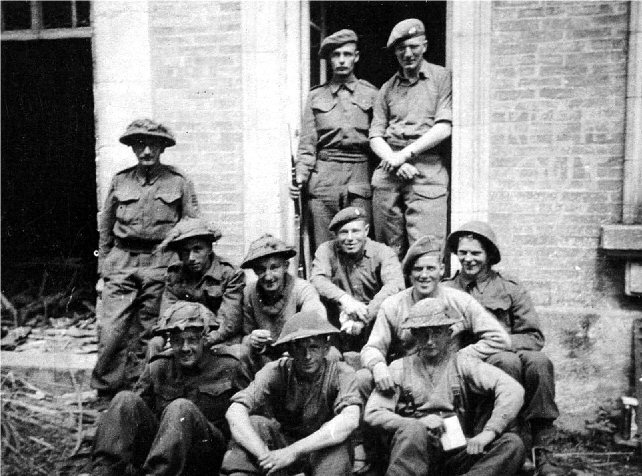
1st Battalion Worcestershire, Men of ‘B’ Company at Mouen
In the doorway: CSM Goddard and Major Algy Grubb
Standing left – unknown
Sitting 2nd row: Lt. Everitt, Lt. Booth, Capt. Newman, Lt. Henry, Pte. Unknown
Front row: Pte. Cameron, Pte. Unknown, Pte. unknown

1st Battalion Worcestershire Men of ‘D’ Company at Mouem (July 1944)
Major Peter Weston (second from right) and C.S.M. Charles Southwood (third from right)
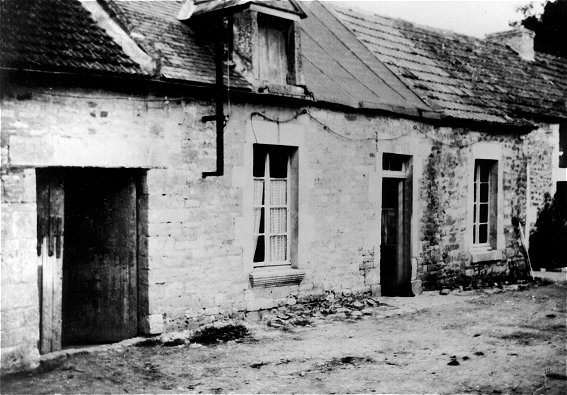
House used by the 1st Battalion Worcestershire Regiment at Baron as a RAP


